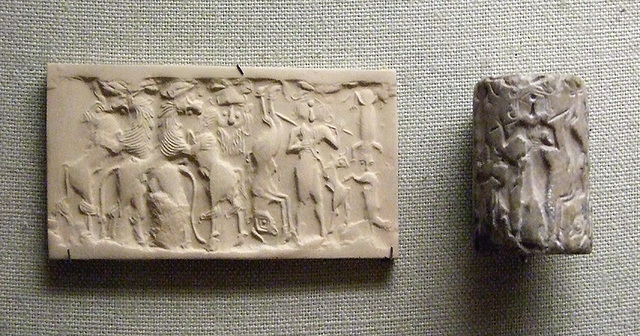Molded Plaque with a Mastiff in the Metropolitan M…
Jemdet Nasr Period Tablet in the Metropolitan Muse…
Vessel Fragment in the Form of a Nude Female in th…
Bowl with a Handle in the Form of a Forepart of a…
Alabaster Cylinder with a Sacred Scene in the Metr…
Female Figure in the Metropolitan Museum of Art, A…
Fragment of a Bowl with a Frieze of Bulls in the M…
Spouted Jug with Raised Concentric Circles in the…
Parthian Figure of a Reclining Woman in the Metrop…
Silver Lid (?) with a Serpent in the Metropolitan…
Gold Reclining Doe in the Metropolitan Museum of A…
Head of a Female in the Metropolitan Museum of Art…
Ivory Plaque with a Griffin Eating a Palmette in t…
Ivory Openwork Plaque with Palm Leaves in the Metr…
Wall Tile with a Fettered Asiatic Captive in the M…
Sasanian Wall Decoration with a Reclining Youth in…
Sardonyx Cameo Portrait of Augustus in the Metropo…
Cameo Portrait of Caligula in the Metropolitan Mus…
Green Roman Glass in the Metropolitan Museum of Ar…
Terracotta Relief of a Nereid Carrying a Cuirass i…
Circular Plaster Relief in the Metropolitan Museum…
Terracotta Vase Fragment with a Relief of Minerva…
Roman Bronze Statuette of a Bull in the Metropolit…
Openwork Plaque with a Rampant Goat Eating a Plant…
Ivory Furniture Plaque: Female Sphinx with Hathor…
Ivory Panel with Griffins Back to Back Against a G…
Ivory Horse Blinker with a Seated Sphinx Wearing a…
Fountain in front of Newly-Constructed Spanish Sty…
Newly-Constructed Spanish Style Apartments in Los…
Fountain in front of Newly-Constructed Spanish Sty…
Newly-Constructed Spanish Style Apartments in Los…
Newly-Constructed Spanish Style Apartments in Los…
Stained Glass Window in a Victorian House in Los A…
A Victorian House in Los Angeles, July 2008
A Victorian House in Los Angeles, July 2008
A Victorian House in Los Angeles, July 2008
Detail of a Victorian House in Los Angeles, July 2…
A Victorian House in Los Angeles, July 2008
A Victorian House in Los Angeles, July 2008
Interior View Through the Windows of Casa Adobe de…
Interior View Through the Windows of Casa Adobe de…
Interior View Through the Windows of Casa Adobe de…
Interior View Through the Windows of Casa Adobe de…
Side View of Casa Adobe de San Rafael in Glendale,…
Casa Adobe de San Rafael in Glendale, July 2008
Location
Lat, Lng:
You can copy the above to your favourite mapping app.
Address: unknown
You can copy the above to your favourite mapping app.
Address: unknown
See also...
Keywords
Authorizations, license
-
Visible by: Everyone -
All rights reserved
-
620 visits
Cylinder Seal and Modern Impression: Bull Man, Hero, and Lion Contest in the Metropolitan Museum of Art, August 2008


Cylinder Seal and Modern Impression: Bull Man, Hero, and Lion Contest
Marble
Mesopotamia
Early Dynastic III, 2600-2334 BC
Accession # 55.65.4
Text from the Metropolitan Museum of Art label.
and
Seals
Although engraved stones had been used as early as the seventh millennium BC to stamp impressions in clay, the invention in the fourth millennium BC of carved cylinders that could be rolled over clay allowed the development of more complex seal designs. These “cylinder seals,” first used in Mesopotamia, served as a mark of ownership or identification. Seals were either impressed in clay masses that were used to close jars, doors, and baskets, or they were rolled onto clay tablets that recorded information about commercial or legal transactions. The seals were often made of precious stones. Protective properties may have been ascribed to both the material itself and the carved designs. Seals are important to the study of ancient Near Eastern art because many examples survive from every period and can, therefore, help to define chronological phases. Often preserving imagery no longer extant in any other medium, they serve as a visual chronicle of style and iconography.
Text from the Metropolitan Museum of Art plaque.
Marble
Mesopotamia
Early Dynastic III, 2600-2334 BC
Accession # 55.65.4
Text from the Metropolitan Museum of Art label.
and
Seals
Although engraved stones had been used as early as the seventh millennium BC to stamp impressions in clay, the invention in the fourth millennium BC of carved cylinders that could be rolled over clay allowed the development of more complex seal designs. These “cylinder seals,” first used in Mesopotamia, served as a mark of ownership or identification. Seals were either impressed in clay masses that were used to close jars, doors, and baskets, or they were rolled onto clay tablets that recorded information about commercial or legal transactions. The seals were often made of precious stones. Protective properties may have been ascribed to both the material itself and the carved designs. Seals are important to the study of ancient Near Eastern art because many examples survive from every period and can, therefore, help to define chronological phases. Often preserving imagery no longer extant in any other medium, they serve as a visual chronicle of style and iconography.
Text from the Metropolitan Museum of Art plaque.
- Keyboard shortcuts:
Jump to top
RSS feed- Latest comments - Subscribe to the comment feeds of this photo
- ipernity © 2007-2025
- Help & Contact
|
Club news
|
About ipernity
|
History |
ipernity Club & Prices |
Guide of good conduct
Donate | Group guidelines | Privacy policy | Terms of use | Statutes | In memoria -
Facebook
Twitter

Sign-in to write a comment.